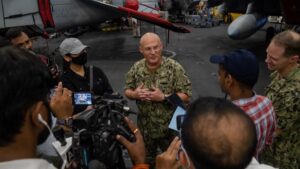
While visiting India last week, the U.S. Chief of Naval Operations (CNO) said the U.S. must work with allies and partners to counter China’s growing military capabilities because it cannot outspend China. In response to an Indian media conference call asking about how the U.S. will address China’s increasing military capabilities and potential in the region, CNO Adm. Mike Gilday on Oct. 12 said the key is focusing on asymmetric advantages of allies and partners. “So the key piece here…

 By
By 











